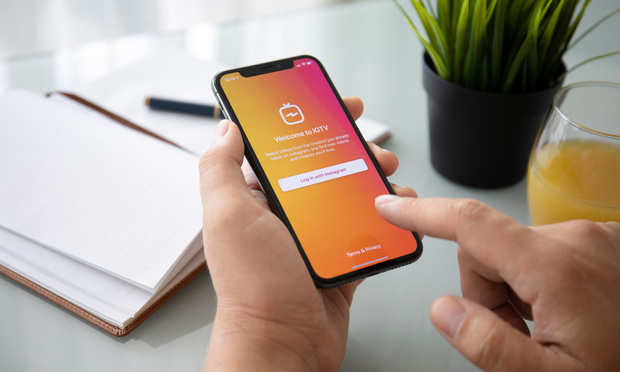Apple and Samsung Sued by Cellphone Users Over Radiation Exposure
San Francisco's Andrus Anderson represents a class action of phone owners who say they would not have purchased or paid top dollar for their cells if they had known about the risks of contact with radiofrequency radiation.
September 11, 2019 at 10:57 PM
4 minute read
The original version of this story was published on The Recorder
 iPhone 10
iPhone 10
Andrus Anderson in San Francisco is representing 16 plaintiffs against Apple and Samsung in a controversy some in the medical and scientific community are allegedly calling "Phone Gate."
The complaint, filed Tuesday in the U.S. District Court for the Northern District of California in San Francisco, claims that members of the class action would not have purchased their phones had they known their Apple and Samsung devices exposed them to radiofrequency radiation exceeding the regulatory limits.
Lawyers from Fegan Scott in Chicago and Shindler, Anderson, Goplerud & Weese in West Des Moines, Iowa, join Andrus in alleging that Apple and Samsung put their clients' health at risk by designing products that emit heightened levels of RF radiation. Too much of the radiation, created by the transfer of energy waves, can increase cancer risks, cause cellular stress and jeopardize reproductive health, according to the complaint.
The Apple and Samsung products that the phone owners say they keep close to their body could exceed exposure limits in some instances by 500%, according to recent studies cited in the lawsuit.
In 1996, the Federal Communications Commission set the limit for RF radiation absorption to 1.6 watts per kilogram averaged over one gram of tissue. However, the complaint cites a test conducted by the Chicago Tribune and the RF Exposure Lab in San Marcos, California, which found exposure rates up to four times the legal guidelines in some phones. With the iPhone 7, the study found radiation exposure increased significantly the closer it was to a person, such as in their pocket or touching their skin, according to the complaint.
"We intend to show that Apple and Samsung were fully aware that they marketed their phones to be used in ways in which testing showed users would be exposed to dangerous levels of RF radiation—without warning consumers," said Elizabeth Fegan of Fegan Scott in an email.
Some of these campaigns include Apple describing its phones as "the internet in your pocket," or "your life in your pocket," disregarding the increased RF radiation risks when the phones are carried in pockets or against skin, according to the complaint.
"Similarly, Samsung markets its smartphones to be used in a variety of contexts, including in bed and against the skin for sonograms," the attorneys write. "Defendants cannot hide behind regulatory compliance on testing to protect its marketing and advertising which knowingly misrepresents the true risks of RF radiation exposure when smartphones are used while touching or in close proximity to the human body."
When asked about the attorneys' plans to demonstrate concrete harm from the alleged exposure, Fegan said that consumers would not have paid up to $1,000 dollars for Apple and Samsung phones had they known the risks. "These damages are recoverable as out-of-pocket losses and/or as the failure to receive the benefit of the bargain under consumer protection laws," she said.
The plaintiffs attorneys filed a similar class action complaint in August in the San Jose division of U.S. District Court for the Northern District of California. The district is no stranger to litigation over potential cellphones' RF radiation emissions. The city of Berkeley and the telecommunications industry has been litigating the enforcement of an ordinance requiring mobile device retailers to warn consumers of potential RF radiation exposure since 2015. Most recently, the U.S. Court of Appeals for the Ninth Circuit affirmed the Northern District of California's denial of a preliminary injunction of the law brought by telecommunications industry group CTIA—The Wireless Association.
Neither Apple or Samsung responded to a request for comment at the time of publication.
This content has been archived. It is available through our partners, LexisNexis® and Bloomberg Law.
To view this content, please continue to their sites.
Not a Lexis Subscriber?
Subscribe Now
Not a Bloomberg Law Subscriber?
Subscribe Now
NOT FOR REPRINT
© 2025 ALM Global, LLC, All Rights Reserved. Request academic re-use from www.copyright.com. All other uses, submit a request to [email protected]. For more information visit Asset & Logo Licensing.
You Might Like
View All
An ‘Indiana Jones Moment’: Mayer Brown’s John Nadolenco and Kelly Kramer on the 10-Year Legal Saga of the Bahia Emerald


Travis Lenkner Returns to Burford Capital With an Eye on Future Growth Opportunities

Legal Speak's 'Sidebar With Saul' Part V: Strange Days of Trump Trial Culminate in Historic Verdict
1 minute readTrending Stories
- 1Chief Judge Joins Panel Exploring Causes for Public's Eroding Faith in NY Legal System
- 2Pogo Stick Maker Wants Financing Company to Pay $20M After Bailing Out Client
- 3Goldman Sachs Secures Dismissal of Celebrity Manager's Lawsuit Over Failed Deal
- 4Trump Moves to Withdraw Applications to Halt Now-Completed Sentencing
- 5Trump's RTO Mandate May Have Some Gov't Lawyers Polishing Their Resumes
Who Got The Work
J. Brugh Lower of Gibbons has entered an appearance for industrial equipment supplier Devco Corporation in a pending trademark infringement lawsuit. The suit, accusing the defendant of selling knock-off Graco products, was filed Dec. 18 in New Jersey District Court by Rivkin Radler on behalf of Graco Inc. and Graco Minnesota. The case, assigned to U.S. District Judge Zahid N. Quraishi, is 3:24-cv-11294, Graco Inc. et al v. Devco Corporation.
Who Got The Work
Rebecca Maller-Stein and Kent A. Yalowitz of Arnold & Porter Kaye Scholer have entered their appearances for Hanaco Venture Capital and its executives, Lior Prosor and David Frankel, in a pending securities lawsuit. The action, filed on Dec. 24 in New York Southern District Court by Zell, Aron & Co. on behalf of Goldeneye Advisors, accuses the defendants of negligently and fraudulently managing the plaintiff's $1 million investment. The case, assigned to U.S. District Judge Vernon S. Broderick, is 1:24-cv-09918, Goldeneye Advisors, LLC v. Hanaco Venture Capital, Ltd. et al.
Who Got The Work
Attorneys from A&O Shearman has stepped in as defense counsel for Toronto-Dominion Bank and other defendants in a pending securities class action. The suit, filed Dec. 11 in New York Southern District Court by Bleichmar Fonti & Auld, accuses the defendants of concealing the bank's 'pervasive' deficiencies in regards to its compliance with the Bank Secrecy Act and the quality of its anti-money laundering controls. The case, assigned to U.S. District Judge Arun Subramanian, is 1:24-cv-09445, Gonzalez v. The Toronto-Dominion Bank et al.
Who Got The Work
Crown Castle International, a Pennsylvania company providing shared communications infrastructure, has turned to Luke D. Wolf of Gordon Rees Scully Mansukhani to fend off a pending breach-of-contract lawsuit. The court action, filed Nov. 25 in Michigan Eastern District Court by Hooper Hathaway PC on behalf of The Town Residences LLC, accuses Crown Castle of failing to transfer approximately $30,000 in utility payments from T-Mobile in breach of a roof-top lease and assignment agreement. The case, assigned to U.S. District Judge Susan K. Declercq, is 2:24-cv-13131, The Town Residences LLC v. T-Mobile US, Inc. et al.
Who Got The Work
Wilfred P. Coronato and Daniel M. Schwartz of McCarter & English have stepped in as defense counsel to Electrolux Home Products Inc. in a pending product liability lawsuit. The court action, filed Nov. 26 in New York Eastern District Court by Poulos Lopiccolo PC and Nagel Rice LLP on behalf of David Stern, alleges that the defendant's refrigerators’ drawers and shelving repeatedly break and fall apart within months after purchase. The case, assigned to U.S. District Judge Joan M. Azrack, is 2:24-cv-08204, Stern v. Electrolux Home Products, Inc.
Featured Firms
Law Offices of Gary Martin Hays & Associates, P.C.
(470) 294-1674
Law Offices of Mark E. Salomone
(857) 444-6468
Smith & Hassler
(713) 739-1250






